The Story of the Wests Secret Nuclear Attacks on Yemen
Gordon DuffApril 7, 2021
Video of a nuclear attack on Syria by Israel, one of several
–
VT: in 2015, Saudi Arabia and Israel began joint operations against Yemen using nuclear weapons. The weapons were deployed by Israeli equipped F 16s but the weapons were from a limited Saudi arsenal of ten nuclear weapons that were built by Israel in the nation of Mali, according to the IAEA.
–
The material for the weapons was stolen from the US with full complicity of the Clinton and Bush governments, over 300 nuclear pits, a project run by Victor Bout, the infamous “Lord of War” and longtime CIA-Mossad asset. We begin with this 2015 story from Pravda.
–
This Russian government publication, published simultaneous to VT’s investigation, analyzes a now banned YouTube video showing a nuclear explosion. We will supply the technical proofs.
–
We were obviously surprised when Pravda “called it” during the nuke attack on Yemen in but failed to do the same when Israel attacked Syria in 2013 in retaliation for sinking one of their submarines.
–
From one of the most classified stories in history, word for word from what used to be information anyone could read….
Syrianews managed to confirm the news we received a couple of days ago that a Syrian Navy boat destroyed an Israeli submarine off the Syrian coast at 150 meters depth on 02 May 2013 around 2 – 2:30 am. We were not told the type or size of the submarine but we were confirmed it was destroyed.
–
In the details we managed to get: the enemy object was detected and orders were given to one of the nearby boats to destroy it which they did with a torpedo (not told which type), then it was monitored sinking until landing on the seabed off the coast. A heavy movement of Syrian Army helicopters was observed over the site where the submarine was destroyed.
–
It’s not the first time Syrian Navy engage with enemy and hostile objects. At the very beginning of the Syrian crisis, the Syrian Navy spotted a German navy ship on a reconnaissance mission and harassed it away, a German minister then complained of the Syrian Navy acts claiming the ship was not spying, just listening and collecting information!
–
Syrian Arab Army
A high number of Israeli spying balloons are seen over the Syrian coast and the Zionists started booby trapping the balloons so they’ll explode when reaching the ground if they’re shot down by the Syrian Army.
–
Worth noting that Israel with US blessing carried out a raid against a chicken hen and a weapons depot near Damascus on 5th of May 2013, 3 days after this submarine was destroyed. The raid was in coordination with ground terrorists from Nusra Front attacking 19 different SAA checkpoints around the Syrian capital very early in the morning.
Following the sinking of the Israeli submarine, with 84 onboard, mostly commandos, Israel hit the suburbs of Damascus with a nuclear weapon. Video has since been wiped off the internet.
Those onboard the sub, other than the small crew, had been planting communication devices disguised as rocks inside Syria. The devices were used to simulate radio broadcasts confirming chemical weapons attacks.
–
As we proceed, you will see, not only assertions but proofs, supplied to VT, including classified documents you can read here, that were used by the IAEA in their investigation of nuclear weapon use by Israel and Saudi Arabia against Yemen and others, real nuclear terrorism so terrible that it never happened, were one to ask Bellingcat or the BBC.
Pravda: Saudi-Israeli Nuclear Strike Hits Yemen
Nuclear strike hits Yemen. Video
Source: YouTube screenshot
Tactical strikes have hit the city.
Shocking video reveals proton bombardment from a neutron bomb.
Israel is reported to be the one to deploy such neutron bombs.

Any doubts about the nuclear attack on Yemen attributed to Israel, as evidenced in two Israeli F16s shot down and forensically identified, are now gone.
Forbidden strikes have brought about a storm of worldwide protest.
Obama has recently promised to provide every assistance including US military force to any “external threat” the rich Arab states of the Gulf may face.
The nuclear attacks on Syria, much as other nuclear attacks, on the US on 9/11 and Oklahoma City, 3 attacks on Syria, the Bali attack, US attacks, many, on Iraq and Afghanistan and the several nukes used on Yemen including one neutron bomb, are among the clearest issues of the massive deception campaign against the people of the world of which QAnon is only one small part. One key background story is here, which includes the strange story of Gary Condit:
This was published in Russia initially, by the Russian Academy of Science, after being fact checked, real “fact checked.”
Then we laid out the case to Russia, the US and UK were too complicit to allow publication, in this piece for the Russian Academy of Science:
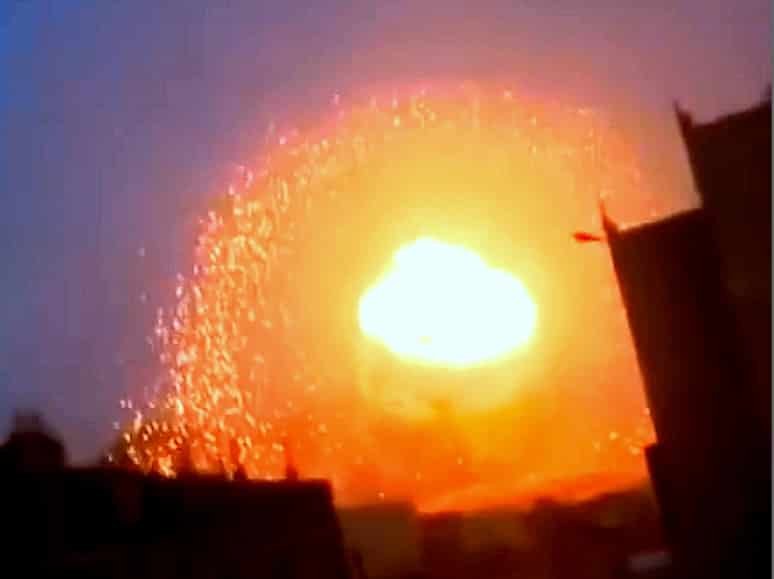 Yemen: Practical Nuclear Survival
Yemen: Practical Nuclear Survival
…by Gordon Duff, VT Sr. Editor, for New Eastern Outlook, Moscow
–
The gloves are off. With proof of a nuclear attack on Yemen saturating “some of the news,” issues of a new reality of war, the covert use of WMD’s by governments, needs to be addressed.
Fabricated claims of nuclear proliferation and other WMD’s has led to invasions, endless threats of war and mindless sanctions while the real use of these weapons, covertly in Ukraine, Syria, Iraq, Afghanistan and Yemen, these and other nations, has killed many and endangered more.
Major national players now resort to tactical nuclear weapons, poison gas, crop diseases and even weather modification as a “cheap and dirty” way of waging “irregular warfare,” part of the Chaos Theory “bag of tricks” that has long included propaganda and false flag attacks.
New Rules
A close look at the terror players in the world, Al Shabab, Boco Harum and ISIS, just to name a few of many, show the active hand of both colonial era and post-colonial era intelligence agencies, British, French, Turkish, Saudi and Israeli with Canada and Germany as well.
America is a different story. It isn’t that America isn’t involved but that much of the involvement is from the private sector, with Bush era military contractors tied to criminal consortiums like the massive world narcotics cartel, now functioning as nation states. The terror organization, Al Nusra, is being trained and equipped to a large extent by drug cartels using CIA and US Department of State contracting firms to supply personnel and even weapons.
The Yemen Bomb
In most of the world, people are aware that there has been at least one tactical nuclear weapon used in Yemen. Jeff Smith, nuclear physicist and former IAEA (International Atomic Energy Agency) inspector said, in 2014, that there had been nearly 50 unauthorized nuclear explosions since 1945. Jeff is citing Bali, Khobar Towers and others, all officially investigated by the United Nations but kept secret.
There was something about the Yemen explosion that has gone viral on YouTube and been featured in the world press, not just Sputnik News, Russia Today, Pravda and FARS, but hundreds of broadcast networks and thousands of newspapers, none in the West. From Pravda, their take, with some curious twists:
“The Saudis have begun to wipe Yemen off the map. (Tactical strikes have hit the city; photo caption)
Shocking video reveals neutron (sic) bombardment from a neutron bomb. Israel is reported to be the one to deploy such neutron bombs.
Any doubts about the nuclear attack on Yemen attributed to Israel, as evidenced in two Israeli F16s shot down and forensically identified, are now gone.
Forbidden strikes have brought about a storm of worldwide protest.
Obama has recently promised to provide every assistance including US military force to any “external threat” the rich Arab states of the Gulf may face. Pravda.Ru”
Pravda names the US, Saudi Arabia and Israel as complicit with Saudi Arabia directly so.
Inexorable Proof
Editors around the world when confronted with a “high risk” story like this were given a choice, at least those areas with a semblance of press freedom. It takes a simple phone call to a local university, getting a particle physicist on the line, and emailing one of the stills or video links.
One thing was universally found to be the case, nuclear weapons were confirmed but no one wanted their name in the article. This would be the end of a career, the end of journal publication of articles, this is how the lid is kept on, how deniability used to work. This is no longer true as we will explain. Now anyone can easily recognize and prove a nuclear attack.
What all the stories have in common is this, none doubt it is a nuclear weapon, there is no doubt. Multiple videos have been posted, all with scintillation evidencing the impact of ionizing radiation only from a nuclear weapons.
You see, modern phones and recent video cameras, both CCD and CMOS, if within the direct blast radius, in this case dangerously close, pick up the direct radiation.
“The combination of the cameras plastic lens and the photoelectric effect produced in the cameras CCD pick up chip (because it is basically a very large array of photo diodes) allows them to act as very good detectors of high level ionizing radiation. Low level radiation in this case is not of concern because it will not immediately kill you or have long term negative health effects.
By simply pointing the camera at an explosive event it will immediately determine if it is nuclear or not. When the camera’s CCD pick up chip is overloaded by excess radiation it will pixelize showing white sparkles all over the picture of the fireball or blast image area.”
The title photo is a screenshot from a video of the May 2015 Yemen explosion, one of hundreds published, from several different videos, all showing the same effect, thus far the best example of this type of video.
Those who took these videos are likely to suffer health problems including multiple myeloma and other cancers, as will any within the blast radius or who visited the site within 72 hours.
https://www.youtube.com/watch?v=pVgPKxYVxb0
You see, modern fission weapons, and this was identified as a fission weapon, a neutron bomb, typically have a fireball radius smaller than 100 yards and can have an ionizing radiation area as little as 500 meters in diameter. This makes them idea for use in the “Third World.”
From Ed Ward, MD:
“Focused nuclear explosions were envisioned in 1959 as a possible concept for propulsion of the spacecraft Orion. The mere directing of the yield was obviously known prior to 1959. Samuel Cohen has stated that a low yield neutron bomb may be tailored to direct yield and proposed the concept more than 35 years ago. An underground detonation causes shaping of the direction of yield as well.
Around 1960, the relatively pure H-bomb was modified for selective effects creating the first 3rd generation H-bomb – the Neutron bomb, Enhanced Radiation Warhead, or a mostly fusion bomb. The neutron bomb’s energy was mostly based on fusion using Deuterium/Tritium with only a small fission component to ignite the fusion reaction. The neutron bombs are designed to release at least 80% of its yield as neutrons at the expense of blast and heat as compared to previous fission-fusion warheads. It was not until around 15 years ago that the existence of the neutron bomb was noted.
It was during this period that a trial regarding Chinese espionage forced the revelation of the neutron bomb. Shortly thereafter, Reagan deployed the W70 version with a yield range of 0.8 kt to 1.6 kt.”
Until the Yemen nuclear explosion, according to Jeff Smith, other attacks were hidden, either misrepresented as Thermobaric or “fuel-air” bombs or as secondary explosions having hit “hidden arms depots.”
Real arms depots explode with secondaries, rocket heading into the air, dense black smoke from chemical fires, and there are endless examples of such explosions, some in Yemen.
From George Paxinos Detonations and Deceit:
“The USA has already used nuclear weapons in Gulf War I and Afghanistan, and is duping us as it prepares to use them again in GWII.
When, on July 16th, 1945, the first atomic bomb was tested at Alamogordo, New Mexico, the USA had a cover story ready to hide this fact: a “Munitions Train” had blown up, people spoke of seeing the flash and hearing the blast, it was all down pat.
In a day and age where information is given out to the public only when such information, or what the so-called “Authorities” tell us is such, serves only the purpose of increasing hegemonic corporate profits at the expense of the many disenfranchised peoples worldwide, it is good to scrutinise what comes down from the simple point of view of: Who Benefits By This?”
I was sent Paxino’s analysis by Jeff Smith.Jeff came forward in 2014 when VT received an Edward Snowden trove refused by CNN, a preliminary 9/11 report done by the Department of Energy and University of California at Los Alamos.
Jeff had been an IAEA inspector until 1997 when he joined the Able Danger investigation along with FBI agent John O’Neill and CIA agent Roland Carnaby. Both O’Neill and Carnaby are dead.
Smith is under a gag order by a Texas grand jury that is in an internal “frozen” investigation of the theft of nuclear material involving world political leaders and imprisoned arms dealer Victor Bout. More from Detonations and Deceit, a Paxinos article from 2003:
“In 1991, a totally gratuitous piece of info was tossed out to the hoi-polloi — meaning us — that the USA was going to use newfangled “fuel-air bombs” in its invasion of the beachheads of Kuwait, along with the proviso, that all media reporting would be subject to a 24-hour news blackout while this went on.
At the time it struck me as odd that a surface-blast weapon, such as a fuel-air bomb, should be used against soldiers who were dug into deep bunkers, and, knowing something of fuel-air explosives and their limitations — also the fact that they produce an oxidised hydrocarbon and particulate metal ash cloud like a small nuclear weapon, and may even, using fuel such as powdered aluminum and magnesium mixtures or alloys, produce both a blinding flash, and perhaps even an electromagnetic signature pulse — they would, to the uninitiated, be fairly indistinguishable from a small nuclear weapon.
Also, alas! — the other way round! — should news be given in advance about their use, one might put in small nukes, such as Neutron Bombs, and nobody who was not an expert and had actually witnessed both could tell the difference, at all.
EXCEPT that in contrast to true fuel-air explosives, neutron bombs WOULD do the dirty on those underground bunkers and their inhabitants, as the neutron-particle rain they produce WOULD be capable of penetrating many meters of earth.”
The Problem
Defining the problem requires analysis of what is at risk. The breadth of the problem is more than the periodic use of nuclear weapons because of a perceived need to deliver ordnance on a subject population with air defenses that prohibit the use of larger, slower and undefendable bombers.
In the case of Yemen, the nations attacking, Saudi Arabia and perhaps Israel as well, Morocco and the Gulf States, have no “heavy lift” aircraft. The MOAB (Mother of All Bombs), which “internet people” love to attribute whenever something unexplained is used is such as case, from GlobalSecurity.org:
“MOAB is a guided bomb which delivers the 18,700 lb BLU-120/B warhead bomb with KMU-593/B GPS/INS. The MOAB is the largest-ever satellite-guided, air-delivered weapon in history [not the largest ever, but the largest satellite guided].
The 21,600-pound MOAB is an improved replacement for the unguided 15,000-pound BLU-82 Daisy Cutter. It is 30 feet long with a diameter of 40.5 inches. The warhead is a blast-type warhead. It was developed in only nine weeks to be available for the Iraq campaign, but it was not used in combat.
The 21,700-pound [9,500 kilogram] bomb contains 18,700 pounds of H6, an explosive that is a mixture of RDX (Cyclotrimethylene trinitramine), TNT, and aluminum. H6 is used by the military for general purpose bombs. H6 is an Australian produced explosive composition.”
The MOAB cannot be delivered by an aircraft in the inventory of any nation but the United States, nor can any of its analogues, the “Daisy Cutter” or fuel air bombs. Other than the B2 “Spirit,” there is no large aircraft deemed survivable in an air defense rich environment such as Yemen, 3 F16s shot down so far. The aircraft that typically carries the MOAB is the C130 Combat Talon:
Where bombs or missiles are claimed to hit “chemical plants” or “arms depots,” in the Ukraine or Syria, Yemen or Afghanistan, it should now be assume that a nuclear weapon was used until proven otherwise.
Governments that use tactical nuclear weapons, and several do, seed conspiracy blogs and comment boards with rumors of “bunker busters,” mysterious chemicals and “energy weapons” as part of the “deception and cover” for “irregular warfare” operations. 9/11 is a prime example.
WMD Defense, The “War of Lies”
Lies are the handmaiden of false flag WMD use, which has become common. When Sarin or Chlorine gas was supposedly used in Syria, when Russian scientists tried to bring soil samples and medical records to the UN Security Council, they were blocked.
Instead, Syrian Human Rights Watch, a London based clandestine group financed by the CIA, submitted their own material, witness statements that quickly fell apart, almost as quickly as the similar “witness statements” accusing Ukrainian separatists of shooting down MH17 with a missile.
A prime example of a disinformation piece is a recent article by Pulitzer Prize winner Seymour Hersh, writing on Osama bin Laden’s death. Every Hersh expose serves an identical purpose, promoting a relatively mild narrative of government wrongdoing in order to cover something far more sinister, making Hersh by far the most successful intelligence asset in history.
His “findings” are always compelling, his work well written and researched, and always a “hijacking” of history, closing off any possibility that mainstream media would ever follow a false flag narrative to its real conclusion.
As with bin Laden, Hersh disputes facts of bin Laden’s death, but not the real facts. Bin Laden’s last CIA certified public statement was in 2001. When a seemingly endless series of “short and fat” bin Ladens, and eventually only audio recordings were “found” by Mossad agent Rita Katz of Site Intelligence, the real bin Laden stayed silent. He died December 13, 2001, something even reported on Fox News, December 26, 2001,in the US.
“Bin Laden, according to the source, was suffering from a serious lung complication and succumbed to the disease in mid-December, in the vicinity of the Tora Bora mountains. The source claimed that bin Laden was laid to rest honorably in his last abode and his grave was made as per his Wahabi belief.
About 30 close associates of bin Laden in Al Qaeda, including his most trusted and personal bodyguards, his family members and some “Taliban friends,” attended the funeral rites. A volley of bullets was also fired to pay final tribute to the “great leader.”
Bin Laden’s history with the CIA, his trips to the US for medical care while listed as “the most dangerous man in the world” and his statements citing 9/11 as an “inside job” all evaporate for history under Seymour Hersh’s skilled hand.
It isn’t just that the controlled press, a worldwide phenomenon media outlets across the globe share common ownership through Israeli and US intelligence assets, censor news. They also support a false narrative reinforced through other assets in the entertainment industry leaving generations of “news aware” people targets of a highly successful self-sustaining multi-generational mind control program.
Those who are propagandized, re-propagandize themselves and then infect others. These were the studies done at the Presidio by Paul Vallely and Michael Aquino for the US Army during the 1980s.
How Can People Fight Back
First of all, recognizing that there are no gas attacks, no germ warfare, no clandestine attacks or false flag terror bombings without the two stage complicity of the mainstream media and the controlled and infected social media and blogosphere.
Beyond that, involvement at a worldwide level, a comprehensive training program in evidence gathering, documenting attacks and of equal or greater importance, seeing to it medical care and decontamination efforts are not derailed as “subversive acts” as happened after 9/11.
Doctors shouldn’t face prison for diagnosing and treating victims of nuclear, biological and chemical warfare attacks perpetrated by major powers who believe they are above the law as long as they control “the narrative.”
Every nation needs to distribute smart phone software for radiation detection, soil sample kits and teams to verify video evidence and interview witnesses and victims of potential WMD attacks.
Only then will the attacks stop.
Gordon Duff is a Marine combat veteran of the Vietnam War that has worked on veterans and POW issues for decades and consulted with governments challenged by security issues. He’s a senior editor and chairman of the board of VT, especially for the online magazine “New Eastern OUtlook
Those confirming proofs were supplied here, by sources at the IAEA:
Nukes on Yemen, Confirming Proofs: Introduction to Nuclear Operations
Introduction to Nuclear Operations
Under the threat of or in actual nuclear warfare, units in the field must continually evaluate the impact that enemy use of nuclear weapons could have on the conduct of operations. They must be prepared for contingency action to reduce the disruption caused by a nuclear attack.
Casualty-producing levels of fallout can extend to greater distances and cover greater areas than most other nuclear weapon effects. Such fallout levels can, therefore, influence actions on the battlefield for a considerable period. Knowledge and understanding of the radiological contamination aspects discussed in this chapter help the commander determine the advantages and disadvantages of each course of action open to him in the execution of assigned missions.
Fallout areas can be the largest contaminated area produced on the battlefield. There is one important aspect of fallout prediction: Winds aloft, as well as surface winds, determine where fallout will occur. Thus, the actual location of fallout can differ appreciably from that which might be expected from the direction of surface winds.
Fallout particles are often visible during hours of daylight. The arrival and settling of dustlike particles after a nuclear burst should be assumed to indicate the onset of fallout unless monitoring shows no radiation in the area. Any precipitation following a nuclear attack must be regarded as rainout from the nuclear cloud. Rainout will be discussed later in this chapter.
The neutron-induced area is small by comparison with the fallout area produced by the same yield nuclear weapon. It is often contained within the area of greatest destruction and collateral obstacles (tree blowdown, rubble, and fire). Frequently, there will be no need to enter the neutron-induced area. Units should move into neutron-induced areas only when necessary. If units are required to pass through GZ or occupy positions in the immediate vicinity of GZ, the induced radiation is operationally significant. Units will base their entry time and stay time on the radiation level present in the induced area. Induced radiation is discussed in more detail in Chapter 7.
The dose rate at any location within a contaminated area does not remain constant. The dose rate decreases with time. Thus, in time a radiation hazard will be of no military significance. The rate at which this decay takes place also varies with time, generally becoming slower as time passes. The decay rate for contamination in an area depends upon many factors. It generally cannot be determined until several series of dose-rate readings are taken for specific locations within the contaminated area. Standard decay conditions are therefore assumed by all units until actual conditions are determined or until higher headquarters directs otherwise.
Nuclear Weapons Effects
To fully appreciate and understand the characteristics of radioactive contamination (fallout) from nuclear detonations, one must first have a basic working knowledge of the origin and nature of these radioactive materials. The overall effects of nuclear weapons depend on the type of weapon, the height of burst (HOB), the distance between the point of detonation and the target, environment in which the weapon is detonated, and the vulnerability of the target.
The normal distribution of energy in a low air burst is depicted in Figure 3-1. The primary focus of this chapter centers on only 15 percent of all energy released in a nuclear detonation. That energy is generally referred to as fallout (both initial and residual radiation) and electromagnetic pulse (EMP).
Initial Radiation Effects
Initial nuclear radiation is emitted within the first minute after detonation. For weapons with yields less than approximately 50 kiloton, initial nuclear radiation is usually the governing effect in target planning. It consists primarily of neutrons and gamma rays. Both types of radiation, although different in character, travel considerable distances at the speed of light, and produce casualties.
Residual Radiation Effects
Residual nuclear radiation is that emitted later than one minute after detonation. It consists of fallout, neutron-induced gamma activity (NIGA), and rainout. Residual radiation (fallout) comes from three basic sources: unused fissionable material, fission products, and neutron-induced activity. These three sources combined emit alpha, beta, and gamma radiation.
The most significant radiation is gamma radiation, which presents a serious personnel hazard because of its range and penetrating power.
Residual radiation is attenuated or scattered in the same manner as initial gamma radiation.
The biological response of humans to residual radiation is essentially the same as their response to initial radiation.
Unused Fissionable Material
Despite the high technology used to produce a nuclear weapon, the weapon itself is still inefficient, to a certain extent, in that all of the fuel, or radioactive material, used to produce the weapon is not expended. This is, in effect, wasted fuel.
At the time of detonation, this wasted fuel is vaporized by the high temperatures of the fireball. As the fireball and subsequent cloud rises and cools, this wasted fuel, now in the form of a gas, condenses back to a solid state. These particles are carried by the wind and are scattered across the surface of the earth as fallout. These particles emit primarily alpha radiation. Considering, however, that alpha only travels in the open air to 4 centimeters from the source and cannot penetrate one to two sheets of ordinary paper, it cannot penetrate the first layer of human skin. Alpha is considered an internal or inhalation hazard. In most situations this internal hazard would not affect the immediate military operation because its effects on the body would not be felt until many years later. Therefore, alpha is not considered to be tactically significant.
Fission Products
In a fission reaction, the basic process that occurs is the splitting of relatively large atoms into much smaller atoms. These smaller atoms are the end result of the fission reaction; they are fission products. These smaller atoms formed in the reaction are atoms of elements in the middle of the table of elements, for example, atoms of mercury, tin, arsenic, iron, and lead. At the instant of the detonation, these fission products are formed as gas. Like the unfissioned bomb materials, they rise with the fireball and smoke cloud. As the cloud cools, they condense into solid particles, consisting of oxides of the elements mentioned above (and many others). These solid particles are carried along above the earth by winds. But, at the same time, they slowly settle toward the earth and appear as part of the fallout.
The isotopes of the elements formed in the fission reaction are radioactive and are, for the most part, beta and gamma emitters. As a result, they do represent a significant contribution to the external hazard from fallout. They actually make the highest contribution, by far, to the gamma activity in fallout.
Beta radiation, emitted in this process has a general range in the open air up to 20 feet, from the source. Beta has the ability to penetrate 1/16 inch of aluminum and may penetrate the first few layers of skin. Beta radiation may also cause a burning of the skin similiar to a first-or second-degree sunburn, or may cause extensive internal damage, similiar to alpha, if inhaled. Therefore, like alpha, beta contamination is not considered tactically significant.
Gamma radiation, however, because of it’s range and penetrating power, is tactically significant and is the primary focus of the rest of this chapter.
Gamma radiation is not a particle or a dust, like alpha or beta. It does, however, penetrate material, but, does not make that material radioactive. Gamma radiation is pure energy traveling through space at the speed of light (186,000 miles per second). It is a form of electromagnetic radiation, differing only in frequency and source from more commonly known forma, such as X-rays, radio waves, and visible light.
Consider radio waves. The human senses cannot detect radio waves. We cannot see, taste, feel, hear, or smell them. The only way we can detect them and make them audible is by the use of an instrument for detecting radio waves, namely, a radio. Similar statements apply to gamma radiation. The human senses are not capable of detecting it. We must have a special instrument for detecting it, an instrument called a RADIAC meter. Radiac meters measure gamma without regard to its source. The dose or dose rates of radiation measured may represent radiation from fallout, neutron-induced gamma activity, or a combination of these.
Neutron-Induced Activity
The third form of radioactivity in fallout is neutron-induced gamma activity, commonly referred to as NIGA or induced radiation. When a nuclear weapon is detonated near enough to the ground to get significant damage or casualties, many of the neutrons released strike in the vicinity of ground zero and penetrate the soil up to a depth of one-half meter. As a result, some of the soil elements, such as sodium, aluminum, manganese, iron, and potassium, become radioactive when hit by neutrons, and produce fairly high dose rates of gamma and beta radiation. This type of residual radiation is called induced radiation. It appears immediately following the burst and can be tactically significant.
Effects of Fallout on Ships at Sea
Ships out to several hundred miles from ground zero may be subject to fallout from surface and some sub-surface bursts. A forecast of the fallout pattern will enable them to take avoiding maneuvers or preventive measures.
Maneuvers to avoid fallout must be based on the naval effective downwind message (NAV EDM). Should it be necessary to pass through fallout, washdown or presetting systems (if available) should be activated, shelter stations assumed, and passage delayed as long as possible.
If these measures are taken, casualties from fallout should be negligible. Ships receiving no warning and remaining within this fallout zone longer than necessary without adopting these preventive measures may sustain serious casualties.
Fallout landing on the surface of the water is rapidly diffused, and there is very little danger to ships passing through water where, for all practical purposes, deposition has ceased.
With the basic understanding of the energy distribution of a nuclear burst, coupled with the basic concepts of the origins of radiation, commanders can translate this information into usable data for tactical units. In determining where radioactive debris may fall on the battlefield, and thus affect those units operating in the area, one must also understand the characteristics of the nuclear cloud. This is important, because the presence or absence of a nuclear cloud will help in determining if the burst was a surface burst (which produces significant fallout). EMP is discussed in more detail in Appendix C.
The size of a nuclear cloud helps estimate yield. Yield estimation is essential in determining the extent of contamination, where the fallout will go on the battlefield, and the duration of tactically significant radiation.
Nuclear Clouds
Detecting the Attack
The development of nuclear clouds is divided into three stages: fireball, burst cloud, and stabilized cloud.
The fireball stage exists from the instant of the explosion until the generally spherical cloud of explosion products ceases to radiate a brilliant light. During this stage, do not look at the fireball. The brilliant light can cause permanent damage to your eyes.
As the brilliant light fades to a dull reddish glow, the fireball stage transforms into the nuclear burst cloud stage. At this point the cloud can be safely observed. The cloud may be either a spherical cloud (high airburst) or a mushroom-type cloud, with or without a stem (low air or surface burst). Relatively low-yield nuclear surface bursts have clouds similar to those produced by surface bursts of conventional explosives. Severe turbulence and rapid growth in cloud height and width are characteristic of this stage.
When the cloud ceases to grow in height, the stabilized cloud stage begins. Height stabilization occurs from about 4 to 14 minutes after the explosion, depending upon the yield. Nuclear burst angular cloud width (line item Lima, as explained in Chapter 2, for an NBC 1 report), and stabilized cloud-top/bottom angle or height (line item Mike) are measured during this stage. Figure 3-2 illustrates the growth of a nuclear cloud. After height stabilization (4 to 14 minutes) the cloud continues to grow. This is due to wind, not nuclear energy. For this reason, cloud measurements are not taken after H + 10 minutes.
Measurements of the nuclear burst cloud are taken at H + 5 minutes (line item Lima) or at H + 10 minutes (line item Mike).
Nuclear cloud measurements (parameters) have been correlated with yield. The results are in nomograms and on the ABC-M4A1 nuclear yield calculator. Use of the nomograms and the ABC-M4A1 is described later in this chapter.
Specifically appointed and trained individuals determine input data at unit level. They are the operators of the angle-measuring equipment listed in Figure 3-3.
Unit SOPs detail the duties and circumstances concerning when and how measurements are taken. For accuracy, the following list of measurements (in order of reliability) is provided to aid in SOP development:
Nuclear burst angular cloud width at H + 5 minutes.
Stabilized cloud-top or cloud-bottom height measured at H + 10 minutes.
Stabilized cloud-top or cloud-bottom angle measured at H + 10 minutes.
Angular Cloud Width
The width of the nuclear cloud is the angular dimension, in mils or degrees, of the cloud diameter. The optical equipment operator takes this measurement at H + 5 minutes. This measurement is made for nuclear clouds resulting from both air and surface bursts (see Figure 3-4). All units have some ability to take this measurement. The lensatic compass should be used if the listed equipment is not available. Use of binoculars for width measurement is extremely inaccurate.
The angular width of the cloud is measured five minutes after the detonation. The equipment operator (of equipment listed in Figure 3-3) measures the azimuth by sighting an azimuth to the left side of the cloud and one to the right side of the cloud. The difference between the numerical values of these azimuths is the angular cloud width. This measurement is reported (in degrees or mils) on line item Lima. Measurement is usually sent in mils.
Stabilized Cloud-Bottom or Cloud-Top Angle
The cloud-bottom angle measurement is the vertical angle (in mils or degrees) measured from GZ level (on ground level, if GZ level is not discernible) to the point of intersection of the stabilized cloud and the stem. Measurement is made at H + 10 minutes (see Figure 3-5). Cloud-bottom or cloud-top angle measurements are not taken for airbursts.
The cloud-top angle measurement is a vertical angle (in mils or degrees) measured from GZ level (or ground level) to the top of the stabilized cloud. This measurement is made at H + 10 minutes (see Figure 3-5).
These measurements are less reliable than measurements made at H + 5 minutes. Most units in the field cannot take cloud-bottom or cloud-top angle measurements. Therefore, they are not normally designated as observer units. These measurements cannot be made with a lensatic compass.
If the angular width of the cloud cannot be measured, the designated observer unit measures the cloud-bottom or cloud-top angle. Nondesignated observer units with angle-measuring equipment can also take this measurement. This measurement is made at H + 10 minutes. It is the vertical angle in mils or degrees from ground level to the top or bottom of a stabilized nuclear cloud. This data is entered as line item Mike.
The individuals specifically tasked to take cloud measurements report this data and other data specified in the unit SOP to the unit NBC defense team. If the unit is a designated observer, the defense team will format the data into an NBC 1 report. The report is transmitted per instructions in FSOP/OPLAN/OPORD or other written directions.
Cloud-Top or Cloud-Bottom Height
Helicopters and most small fixed-wing aircraft have a limited capability to determine cloud height. Surface ceiling and enemy ADA threat are the principal reasons for this limited capability. This measurement can be made with high-performance USAF, USN, and USMC aircraft. NBCC must coordinate with other service liaison officers to make arrangements to measure cloud height.
Cloud height can be measured with radars. Again, NBCC coordination is required to establish this data source. Radar may also be helpful in resolving actual number of bursts, GZs, and yields.
Observer Position
Use UTM coordinates or use a place name. Enter this location on line item Bravo of the NBC 1 nuclear report. Line item Bravo is required on all reports from ground observers and should be encoded. This is the location of the angle measuring equipment. It may or may not be the unit’s location.
Another important factor in determining the extent and effect of nuclear detonations is the location of ground zero (GZ). This is reported as line Foxtrot on the NBC 1 report.
Location of Ground Zero/Azimuth to the Attack
If the GZ cannot be observed, measure the azimuth from observer to the center of the stem (surface burst) or nuclear burst cloud (air burst). Enter this data as line item Charlie of the NBC 1 nuclear report. If the GZ can be observed, determine the UTM coordinates or place name. Enter this data as line item Foxtrot (actual). Omit line item Charlie. (Aerial observers may provide estimated or actual GZ, depending on altitude, orientation, terrain, and visibility conditions). GZ must be observed to use line item Foxtrot (actual).
Unit Level Procedures
Unit level is defined as any level that does not have an organic NBCC. Unit level procedures for locating GZ and estimating yield are much leas complicated. The emphasis is placed on speed of the calculation, rather than on accuracy. The NBC 2 report depends heavily on radio nets. The integrated battlefield will pose serious communications problems to these nets.
Changing frequencies and call signs several times a day causes other problems. All these problems, coupled with an aggressive enemy electronic warfare program, will delay message traffic between higher and lower headquarters. Therefore, at the unit level, an independent means of calculation must be used until the NBC 2 report data reaches this level.
Any unit that is not part of the designated observer system is obligated to take cloud measurements to the best of its ability and record all observed burst data. These data are recorded in the NBC 1 nuclear report format. They are not reported to higher headquarters unless specifically requested. All units use this data to locate GZ and to estimate yield.
Location of Ground Zero
At unit level, GZ is located in either of two ways. For small yield weapons, direct observation may provide actual GZ location. Units do not, however, reconnoiter for the GZ location. The other method used at unit level is called the polar plot (see Figure 3-6).
Unit commanders are interested in obtaining a gross fix on the GZ location. This enables rapid evaluation of the burst to estimate the situation. Polar plot techniques are based on flash-to-bang time and the speed of sound (350 meters per second or 0.35 kilometers per second). The NBC defense team makes an approximation of the distance between GZ and the observer, in kilometers. They multiply the flash-to-bang time (data on line item Juliet of the NBC 1 report) by 0.35 kilometers per second.
Distance between GZ and observer = flash-to-bang time (sec) x 0.35 km/sec
Once this distance has been established, perform the following four steps:
Step 1. On the situation map, plot the observer location. This is line item Bravo on the NBC 1 nuclear report.
Step 2. Using a protractor, mark the azimuth from the observer position to the attack location. Convert magnetic azimuth to grid azimuth. This information is found on line item Charlie of the NBC 1 report.
Step 3. Draw this azimuth to the length previously calculated as the distance between GZ and the observer.
Step 4. Read the grid coordinates of the place where the azimuth line in Step 3 ends. This is an approximate plot of the GZ location.
Yield Estimation
On Shore
Only higher headquarters will have classified intelligence data that can be used as a comparison tool for resolved yield. Also, unit-level work conditions will be so varied that the use of nomograms will be difficult in most cases. Few, if any, units will have sufficient personnel to dedicate to an NBCC-type mission. Commanders at these levels need only an approximate yield value for entry into the broad yield groups of the effective downwind message.
This message is used for the simplified fallout prediction, discussed in detail later in this chapter. In any case, the apparent accuracy of the yield estimation nomograms is unnecessary.
The M4A1 nuclear yield calculator (Figure 3-7) is designed to provide rapid yield estimation based on any parameter except cloud-top or cloud-bottom height. This calculator is a part of the M28A1 RADIAC calculator set, NSN 6665-01-130-3616. Instructions for use of the M4A1 calculator are on the instruction card in the set. This card also provides check problems. Upon receipt of the M4A1 calculator, the user should solve the example problem on the instruction card. If the calculator will not solve the example problem to within the specified tolerance, it must be destroyed and a new one obtained. Complete operating instructions for the M4A1 are in TM 3-6665-303-10.
There is one problem with the M4A1 calculator of which the unit NBC defense team must be aware. The calculator is a round nomogram with a fixed hairline. Because of this, there are situations in which the yield pointer may go off scale on the high or low ends of the yield scale. Additional burst information should clarify unexpected yield estimates not consistent with the use of tactical nuclear weapons. Familiarity with the calculator and an understanding of the size of a nuclear cloud in relation to the observer-GZ distance (flash-to-bang time) will eliminate these problems.
For example, a nuclear cloud is 20 mils wide. Flash-to-bang time was 10 seconds. This is a small cloud that is very close to the observer, indicating a small yield. The calculator shows a yield of 1,000 kilotons, but the actual yield is less than 0.02 kiloton. Conversely, a nuclear cloud-top angle of 80 degrees with a flash-to-bang time of 120 seconds is a large cloud very far away. This time the calculator shows a yield of 0.02 kiloton, but the actual yield is greater than 10,000 kilotons.
The M4A1 calculator is a rapid yield-estimation method designated specifically for unit level use. Its durability, size, and ease of operation make it the most suitable method. All members of the unit NBC defense team are trained in its use. Nomograms are not used at unit level because of adverse conditions.
The GZ location and estimated yield calculated at unit level are used to create a simplified fallout prediction. Upon receipt of the NBC 2 report from the NBCC, the original simplified fallout prediction is revised, using the new data. When the NBC3 report is received, it supersedes the revised simplified fallout prediction. This approach allows the unit commander to make estimates and decisions based upon the best available information at that time.
Onboard Ships
If stabilized cloud-top height or cloud-bottom height can be measured, then Figure 3-8 may be used to estimate the yield. Line up hairline with information given on line Mike, (convert from meters or feet to kilometers or thousands of feet.) Pin down where hairline crosses line in graph. Then plot so hairline is parallel. Read weapon yield on bottom of graph. When cloud-top or cloud-bottom parameters are not available, ships will have to use the methods described in the preceding paragraphs for ground forces.
Significance of Fallout Ashore Versus at Sea
The detailed and simplified procedures for fallout prediction are intended for use by all three services. The predictions are based on assumed land surface bursts. It is recognized that the fallout from a sea surface burst may be different, but very little direct information is available on fallout from bursts on the surface of deep ocean water.
It also must be stressed that the sea acts as an absorbent of and shields against radioactive products. But, these products may remain a hazard on land until they have decayed.
Another important difference is that recipients of warnings ashore do not have the mobility of ships at sea, and in most cases must deal with the hazard. Therefore, ships will be particularly interested in the determination of the approximate area where fallout will reach the surface at a given time after burst.
Ships with a meteorological capability maybe able to obtain the required meteorological data for computation of effective downwind, using standard pressure level winds. Basic wind data for this purpose are generally available also from meteorological sources (airbases, meteorological ships, or mobile weather stations).
Ships which do not have a meteorological capability will normally predict fallout areas by using the simplified procedure. Fallout prediction and plotting of fallout areas on board naval ships is discussed in this chapter.
Flash-to-Bang Time
At the instant of the blue-white flash, cover eyes, hit the ground, and start counting slowly–1,000 and 1, 1,000 and 2, 1,000 and 3, and so on–until the arrival of the shock wave or bang. Make a mental note of the count on which the shock wave arrives (for example, 1,000 and 4). If the observer has a watch and can note the exact time (in seconds), the watch can be used to record the flash-to-bang time. This data is entered as line item Juliet on the NBC 1 nuclear report. Remain where you are until debris has stopped falling. It must be noted that there will be two shock waves–one blowing in one direction, and the other blowing a few minutes later in the opposite direction. If the bang is-not heard in five minutes (a count of 1,000 and 300), continue with other measurements.
Type of Burst and Time of Attack
After the second shock wave has passed, uncover your eyes, and read the watch to the nearest minute. This data is entered as line item Delta of the NBC 1 nuclear report. Observe the developing cloud to see if the burst was an airburst by noting the shape and color of the cloud or the absence of a stem. If the cloud is lighter in color than the stem, or if the stem is ragged or broken (does not solidly connect with the cloud), record “air” as line item Hotel of the NBC 1 nuclear report. If the stem is thick and dark, and it connects with the cloud, record “surface” as line item Hotel. When the cloud does not match any mental image for air or surface, record “unknown” as line item Hotel.
“Unknown” also may be recorded whenever the attack occurs at night. A subsurface burst is recorded as “surface,” only if the detonation ruptures the surface. This of data also is recorded on line item Hotel.
Recording and Reporting Nuclear Burst Data
Each unit, designated and nondesignated, uses the data to locate GZ and estimate the yield. Polar plot techniques are used to locate GZ. Yield is estimated with the M4A1 yield calculator. GZ and yield are used with the effective downwind message to make a simplified fallout prediction. Effective downwind messages and simplified fallout predictions will be explained later in this chapter. This prediction is used until the NBC 2 report is received. Then the simplified fallout prediction is revised and reevaluated. The NBC 3 report will follow later. The NBC 3 report is more accurate and supersedes all simplified predictions.
Examples of nuclear burst reports are shown in Figure 3-9. These reports follow the standard NBC 1 nuclear report format. These examples in no way limit the variety of reports. Further, unit NBC defense teams are not confined solely to the use of the line items in these examples. Other line items may be added at the user’s discretion.
Evaluating Data
Data evaluation consists of locating GZ, estimating the yield of the weapon, confirming the date-time group of the burst, and assigning a strike serial number. It is performed at the NBCC. If the unit level establishes a serial number, it will only be for that unit’s use and never transmitted higher.
All calculations of GZ locations and yields developed at unit level are estimates. These calculations are based on data gathered by one unit. Methods of calculation are simple and abbreviated. These reports also contain other data. Unit-level estimations are never transmitted to higher headquarters.
The NBCC is responsible for the NBC 2 report. This report reflects the GZ location, yield, and other data that the entire command will use for fallout predictions. This ensures that all units will make the same fallout prediction.
NBCC Procedures
NBCC techniques compare the data from many sources. Much of this data is not available to any one unit. Only the NBCC is authorized to assign strike serial numbers. This is generally from a block of numbers assigned to the division by corps. This block of serial numbers is usually listed in FSOP/OPLAN/OPORDs. The serial numbers usually identify the corps, division and/or brigade areas, and the number of the strike.
Date and Time of Attack
The date and time of the attack are always reported. The time zone used is specified by FSOP/OPLAN/OPORD or is contained in other instructions. The NBCC conducts time checks with designated observers and converts all times to Zulu time.
Ground Zero Location
At the NBCC, GZ location is always located before the yield is estimated. The NBCC uses several methods and data sources to locate GZ. Some of these methods are plots of intersecting azimuths, radar reports, and aviator reports. If line item Foxtrot (actual) data on the NBC 1 report is not available, other methods are used to confirm this data. When azimuth data are incomplete, arcs for radii of flash-to-bang distances from two or more observers can be used. The NBCC can request NBC 1 reports from nondesignated units to supplement data from designated units.
Combinations of azimuths and radii of flash-to-bang distances also can be used. This is done by multiplying flash-to-bang time submitted on NBC 1 reports by the speed of sound (0.35 kilometers per second) to determine a distance. Once the observer location has been plotted, the flash-to-bang time distance can be drawn as an arc. If several arcs can be drawn, a gross fix of GZ can be determined. This is the most accurate method to estimate the location of GZ. See Figure 3-10.
The principal GZ location method is a plot of intersecting azimuths sent by designated observers. (This information is found on line item Charlie of the NBC 1 reports.) To locate GZ using a plot of intersecting azimuths, follow these four steps:
Step 1. On the operations map overlay, locate and mark the position of each observer unit, using data at line item Bravo. Line item Bravo must be encoded if using an unsecure radio net. Therefore, these observer locations may have to be decoded prior to actual plotting.
Step 2. Determine each azimuth to be plotted. (This information is at line item Charlie.) Convert all magnetic azimuths to grid azimuths. Using a protractor, mark each azimuth from each observer position. Draw each azimuth to the distance necessary for them to intersect.
Step 3. Post any data that assists in the determination of GZ location (such as, radar reports and pilot reports).
Step 4. Evaluate the data. The result of intersecting azimuths is an estimation of GZ location. GZ location is reported on the NBC 2 report at line item Foxtrot, qualified with the word “estimated,” unless Foxtrot (actual) information is used in the determination. Line item Foxtrot must be encoded if using an unsecure radio net.
In using this summary, the NBCC compares the estimated yield with known enemy yields. The estimated yield and other intelligence sources, such as delivery means, depth of the attack from the front line of troops, type of burst, and other circumstances concerning the attack, will indicate which known enemy yield was actually used. Only this resolved yield is reported to field units. A simplified summary of enemy nuclear capabilities is shown in Figure 3-11.
Disregard azimuths that do not intersect with other azimuths. Whenever azimuths do not cross to form a clear GZ location, the center of the plot is taken as GZ location. The NBCC will request exact GZ coordinates from aviation assets when aviation missions permit. Figure 3-12 shows an intersection of azimuths for GZ location.
Another GZ location technique involves the use of line item Papa Alfa. Some air defense artillery radars have the ability to paint an outline of the nuclear cloud on radar scopes. The radar operator can determine coordinates of H + 5 minutes after burst, which outline the stabilized nuclear cloud as if it were viewed from the top. These coordinates may be sent as UTM coordinates. Coordination between the NBCC and the unit that sends radar data is required. This coordination must establish precedence of the report and communication channels to be used.
Upon receipt of the data at the NBCC, the coordinates are plotted on the map, and the cloud contour is drawn. The center of the outline is the GZ location. If the measurements are taken at H + 5 minutes after burst, there is a high assurance that GZ has been accurately fixed. This GZ location technique is most valuable at night or when observer data cannot fix GZ location with 90 percent or greater assurance.
Yield Estimation
Before the yield can be estimated, you must know the location of GZ and the position of the observer when the cloud measurements were taken. Rather than require field personnel to solve complex formulas, the nuclear burst parameters are presented in nomograms. Each is an independent means of estimating yield. Emphasis is on estimating the yield. All nomograms are designed to provide approximate yields.
Flash-to-bang time (line item Juliet) is not used at NBCC level for yield estimation, except as a last resort. This information is usually regarded as unreliable because of the stress associated with slow counting immediately after an attack. Instead, the NBCC uses the distance (in kilometers) between GZ and the observer. Plotting this data (intersecting azimuths) represents the best method of determining the distance between GZ


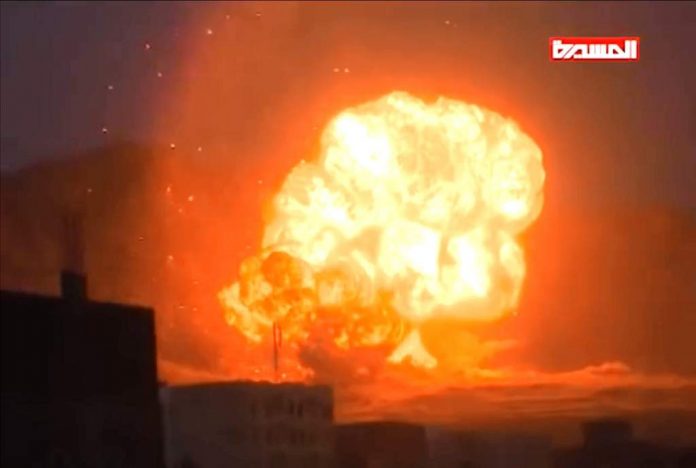
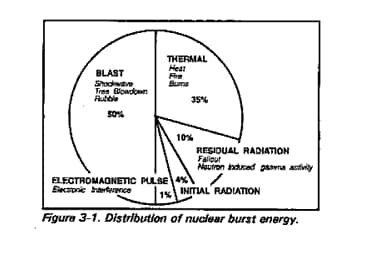
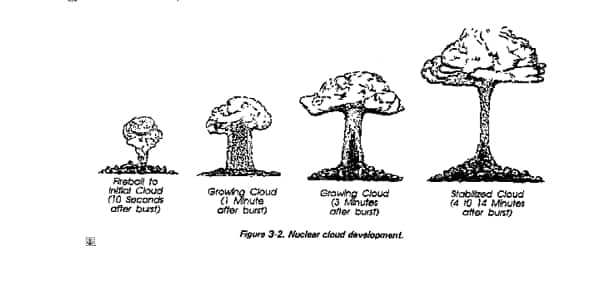
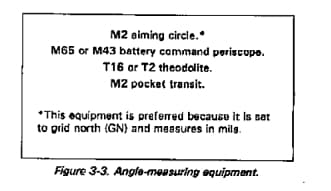
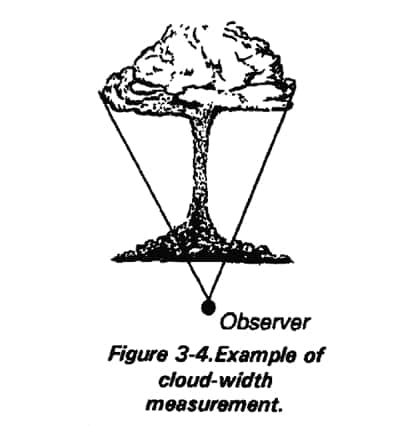
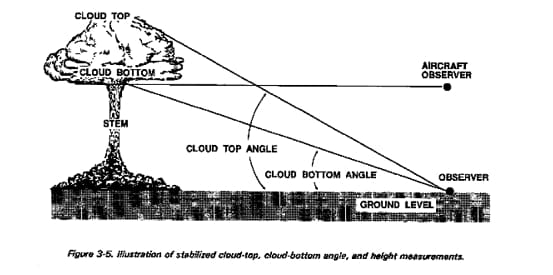
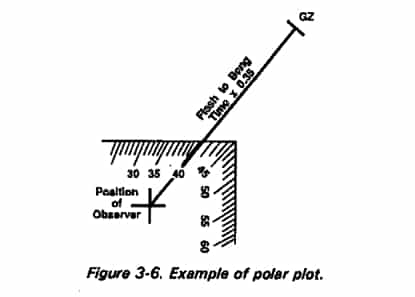
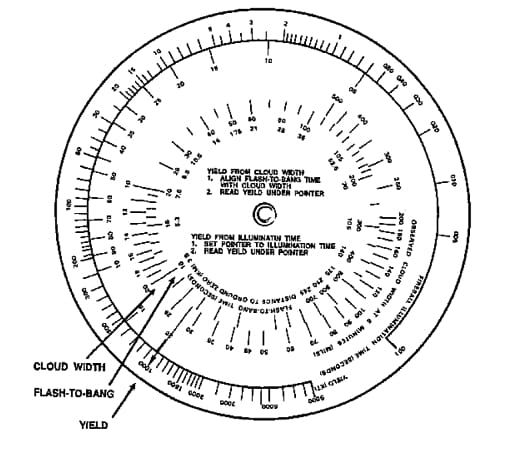
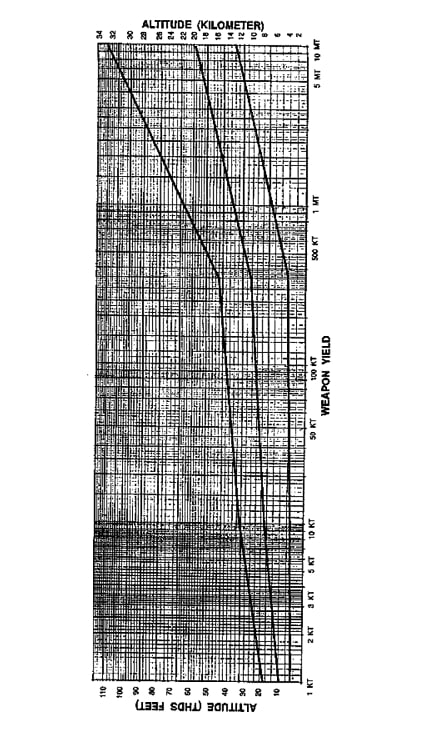
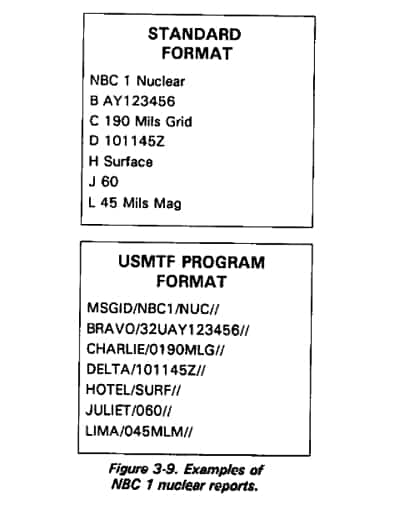
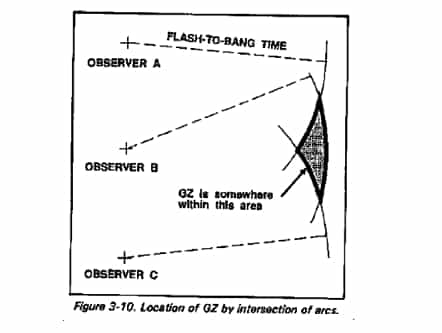
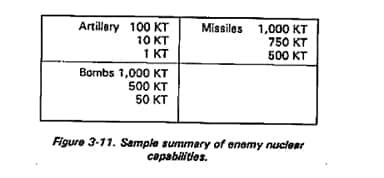
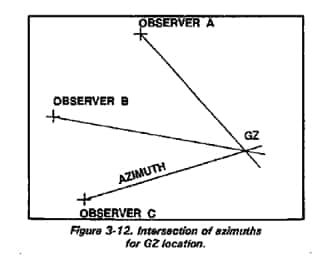

No comments:
Post a Comment